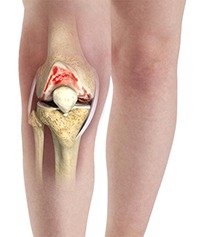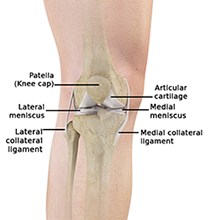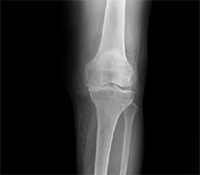Knee Arthritis
General Information
The term arthritis means painful or inflamed joint. There are many causes of knee arthritis but there are three basic types that affect the knee joint.
Osteoarthritis
Osteoarthritis (OA) is the most common form of arthritis affecting the knee joint. OA is a condition in which the joint articular cartilage is gradually worn away. This is usually a slow progressive process and often occurs in patients who are middle aged or older. There is no one cause for osteoarthritis.

There are, however, several factors that increase one’s risk of developing OA. These includes genetic factors, increased body weight, increasing age, gender and previous trauma to your knee.
Rheumatoid arthritis
Rheumatoid arthritis (RA) is an inflammatory type of arthritis where the lining of the joint (synovium) becomes inflamed. RA can occur at any age and tends to be more common in females. As a general rule RA affects both knees. As the synovial lining of the joint becomes more inflamed, abnormal chemicals are released into the joint which can slowly destroy or eat away the articular cartilage of the joint.
Post-traumatic arthritis
Post-traumatic arthritis develops after one or multiple injuries to the knee. This type of arthritis eventually progresses to osteoarthritis and may develop after a fracture (broken bone), a ligament tear (such as an ACL tear) or a tear of the meniscus.

Symptoms & Diagnosis
Pain, swelling and stiffness are the typical symptoms of knee arthritis. Painful knee arthritis generally develops over a long period of time. It is possible, however, to have exacerbations (flare ups) of pain which settle with rest. As arthritis progresses, the joint eventually becomes more stiff and swollen, making it difficult to bend or straighten the knee.
Initially pain occurs with weightbearing, however, as arthritis progresses you may also notice knee pain at night and when sitting down (rest pain). The pain may often cause a feeling of weakness in the knee resulting in a locking or buckling sensation. People with knee arthritis often complain of worsening pain with changes in the weather.
Diagnosis

Your surgeon will take a detailed history from you about the symptoms you have been experiencing. Additionally a physical examination will focus on your ability to walk, the ability to straighten and bend your knee, and will also assess for areas of tenderness around the knee.
Your assessment will also include a series of x-rays which will look for the loss of joint space between the bones of your knee. As cartilage does not show up on x-rays, arthritis appears as a loss of this space between the bone ends of your knee joint. Sometimes additional tests such as a blood test and an MRI scan may be required to exclude other conditions.
 healthin
healthin